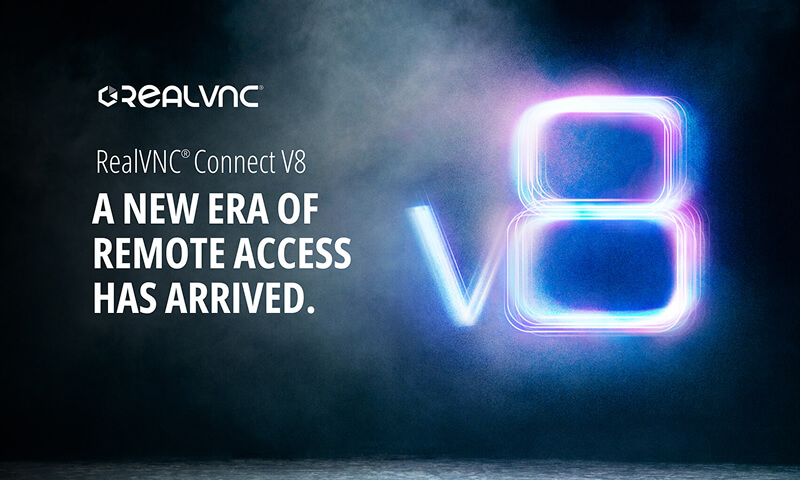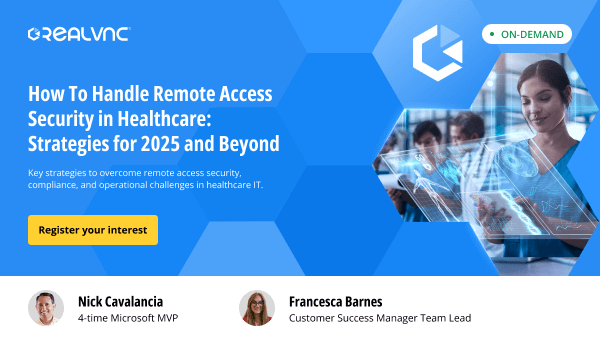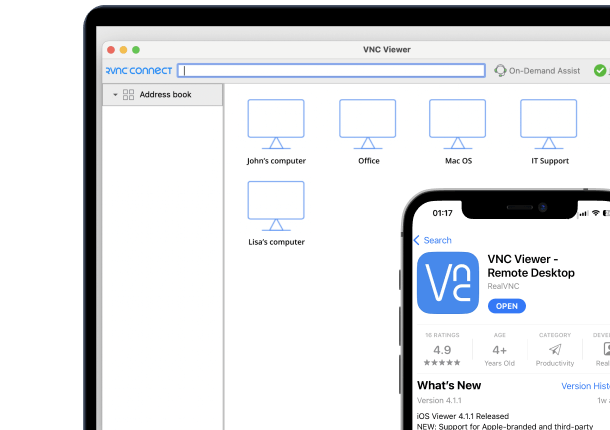Open-source VNC software can be a great starting point. It’s free, flexible, and widely available. For teams building proofs of concept or early-stage tools, it often feels like the smart choice. But as your product matures, cracks start to appear. What once saved time and money can begin to hold you back.
This post explores why many businesses make the switch from open-source to proprietary SDKs. We’ll look at the early appeal of open-source, the tipping points that trigger a change, and what companies gain by moving to a commercial solution.
Starting With Open-Source: Why It Works (at First)
Open-source remote access tools like TightVNC, TigerVNC, or UltraVNC offer an easy way to implement functionality quickly without licensing costs. They’re especially popular among developers who want to prove a concept or get an MVP out the door quickly. For many, these tools deliver just enough to meet short-term goals.
Typical Use Cases:
- Internal tools for QA, monitoring, or testing
- MVPs and product demos
- Educational labs and classroom setups
- IT support in small businesses
- Lightweight customer support tools
- Projects with short lifespans or limited scope
- Hackathons and prototype builds
In these contexts, open-source makes a lot of sense. You get full control over the codebase, and you’re not locked into a vendor. But once you’re preparing to scale or commercialize, limitations start to emerge.
Checklist: Is It Time to Switch?
Before diving into deeper comparisons, it helps to take a step back and ask a few honest questions. Many teams using open-source tools find themselves patching problems and working around limitations more than they expected. This checklist can help you evaluate whether your current setup is still the best fit for where your product is headed.
Not sure if you’ve outgrown your open-source solution? Use this checklist to see if it’s time to consider a proprietary SDK:
- Are your customers asking for features like encryption or role-based access?
- Has your legal team flagged concerns about open-source licensing?
- Is your dev team spending more time maintaining infrastructure than building your product?
- Are you preparing for compliance certifications like ISO 27001 or SOC 2?
- Do you need to support a growing fleet of devices with consistent performance?
If you answered “yes” to two or more, it may be time to explore other options.
Where Open-Source Software Starts to Struggle
At some point, most teams find that the solution that helped them get off the ground isn’t enough to keep pace with their goals. As use cases become more complex and expectations grow, open-source tools begin to show their limitations. These challenges can start small but become more costly and time-consuming as you scale.
Teams often run into the same set of problems when trying to stretch open-source solutions into production-ready platforms.
| Challenge | What It Means for Your Business |
| Complex licensing terms | May require you to expose proprietary code and navigate unclear legal obligations |
| Outdated security features | No built-in encryption or secure authentication with no regular, independent security testing by experts |
| Limited scalability | Slower performance and limited functionality due to reliance on outdated protocols (e.g. RFB 3); no audio support hampers full-featured solutions |
| Legacy connectivity model | Traditional open-source VNC relies heavily on point-to-point LAN connections, which are ill-suited for cloud-native or distributed environments. Remote connectivity often requires port forwarding or VPNs, which can introduce security risks and user friction. |
| No support or SLAs | Break-fix issues must be handled entirely in-house, increasing developer burden which costs time and money. |
| Difficult compliance | Compliance with regulations like GDPR or ISO 27001 is more time-consuming and costly without built-in support |
| Uncertain future development | No predictable roadmap; you’re reliant on volunteer contributors to implement or maintain key features |
This outdated connectivity model is especially problematic in cloud-first architectures. If your product or service requires secure, seamless access across firewalls, NAT, or from mobile users, open-source VNC often can’t deliver the simplicity or reliability users expect today.
Security Audit Walkthrough
Security and compliance are no longer nice-to-haves. They’re core requirements for doing business, particularly in industries handling sensitive data. If your remote access layer can’t meet audit standards or requires major customization to pass, it could cost you customers or delay critical certifications.
Preparing for a security audit with open-source software can be a major undertaking. You may need to:
- Document every customization made to the codebase
- Add encryption and authentication manually
- Build out audit logging systems
- Prove your system meets specific data privacy regulations
With a proprietary SDK, many of these elements are already built in. Vendors often provide:
- Documentation templates
- Compliance support resources
- Pre-configured audit trails
- Trusted encryption protocols
This reduces both the time and cost required to achieve and maintain compliance.
Technical Deep Dive: Feature Comparison
If you’re weighing open-source versus proprietary options, a feature comparison is a good place to start. Many open-source tools provide only the fundamentals and leave advanced capabilities up to the implementer. A commercial SDK typically includes everything needed to deploy securely and at scale.
Here’s a closer look at how common open-source VNC tools compare with a typical commercial SDK:
| Feature | Open Source VNC | Proprietary SDK |
| Encryption | Often basic or manual | Built-in TLS/SSL, enterprise-grade |
| Authentication | Basic username/password | Multifactor, token-based |
| Session Management | Limited | Full control, audit logs, role access |
| Bandwidth Optimization | Minimal | Adaptive streaming, compression |
| Mobile/Embedded Support | Variable | Optimized SDKs available |
| Update and Patch Frequency | Community-dependent | Regular updates, vendor maintained |
| Cloud Connectivity | Relies on direct IP or VPN setups | Cloud-brokered sessions, NAT traversal, and firewall-friendly outbound-only connectivity |
Total Cost of Ownership: The Real Comparison
While open-source software is often chosen to reduce upfront costs, it’s important to look beyond licensing fees. Engineering time, maintenance, legal risk, and customer experience all contribute to the total cost of ownership. What looks free at the beginning may carry significant hidden costs over time.
Free tools can get expensive quickly. A solution that costs nothing upfront may demand more from your developers, legal team, and support staff over time.
| Factor | Open Source VNC | Proprietary SDK |
| Upfront Cost | Free | Licensed, predictable cost |
| Engineering Time | High | Lower with purpose-built tools |
| Security Features | Basic, often manual | Robust and automatic |
| Legal and IP Risk | High with copyleft licenses | Low with commercial terms |
| Compliance Burden | Handled in-house | Vendor-provided tools and audit trails |
| Customer Support Experience | Open-source VNC places onus on you to conduct thorough testing and analysis, adding to cost and timelines | Vendor provides a product that’s pre-screened and certified for compliance with regulatory standards |
| Cost Over Time | Grows with scale | More stable and predictable |
When you’re responsible for delivery at scale, total cost matters more than initial price.
Why Companies Make the Switch to a Proprietary SDK
After facing repeated roadblocks with open-source tools, many teams decide it’s time for a more reliable and scalable solution. Proprietary SDKs are designed to serve commercial use cases from day one, offering stability, support, and a forward-compatible foundation for growth.
These platforms are built with production demands in mind. Rather than spending time fixing gaps, teams can focus on delivering great user experiences and scaling with confidence.
What You Gain:
- Clear licensing with no legal grey areas
- Strong security with encryption and user and permissions management built in
- Tools and documentation that speed up integration
- Performance that scales with your user base
- Access to expert support when needed
Real-World Example: When Open-Source Wasn’t Enough
Stories from the field can make the challenges and benefits more tangible. Here’s one example of a company that hit the limits of its open-source setup and decided to make the switch. The impact on both their product and business operations was significant.
A digital signage company built its first remote support feature using open-source VNC. It worked well during development. But once devices started shipping to customers, serious issues began to surface.
- Legal flagged GPL terms that could expose their proprietary IP
- Field engineers struggled with flaky connections
- Security gaps ruled out enterprise contracts
- They replaced the open-source tool with a commercial SDK and saw immediate improvements.Development effort dropped by more than half
- The platform passed ISO compliance audits
- The company added branded, secure access to over 30,000 devices
- The switch enabled them to launch a stronger product, faster.
Futureproofing: Planning for Growth
Your product isn’t static, and your remote access layer shouldn’t be either. As you expand into new markets, support more users, or adopt emerging technologies, you need a solution that evolves with you. A proprietary SDK can offer this flexibility, helping you stay competitive and compliant over time.
Technology and compliance standards are evolving fast. What works for your current product might not meet tomorrow’s needs. Proprietary SDKs are regularly updated to meet new security benchmarks, support new device types, and integrate with other systems.
Some examples of future-focused benefits:
- Support for zero-trust architecture
- Secure cloud connectivity across distributed environments
- Cloud-native deployment options
- Integration with identity providers like Okta or Azure AD
- Compatibility with IoT and edge devices
Modern SDKs are built to accommodate today’s service-based architectures. They support connections initiated through cloud brokers or relay servers, eliminating the need for complex network configuration. This is vital as more products move toward SaaS, remote device management, and global customer support.
By choosing a commercial SDK, you’re not just solving today’s problem. You’re building a platform that can scale and adapt as your product and customers grow.
Should You Make the Move?
Deciding when to upgrade from open source to a commercial SDK isn’t always obvious. But if your team is investing more time in maintaining your infrastructure than improving your product, it might be time to make the switch. Use the following prompts to guide your thinking.
Open source is ideal for testing and learning. But when your business depends on stability, security, and scale, a proprietary SDK often delivers better results.
Consider switching if:
- You’re preparing to launch a commercial product
- Customers are asking for better security and reliability
- Your team is spending more time maintaining infrastructure than building features
A commercial SDK can help your team deliver faster and grow with confidence.
If you’re interested in learning more about embedding secure, scalable remote access into your product, there are two great next steps:
- Read our eBook: Master Remote Access Integration: The RealVNC OEM & SDK Playbook — A practical guide to designing, deploying, and scaling remote access as part of your solution.
- Listen to our podcast: Remote Access Redefined — Insightful conversations with product leaders, engineers, and security experts about the role of embedded remote access in today’s connected world.
Explore the best path forward and see how a modern SDK can support your roadmap. Alternatively, if you are after a ready-made integration, explore RealVNC’s OEM solution.
